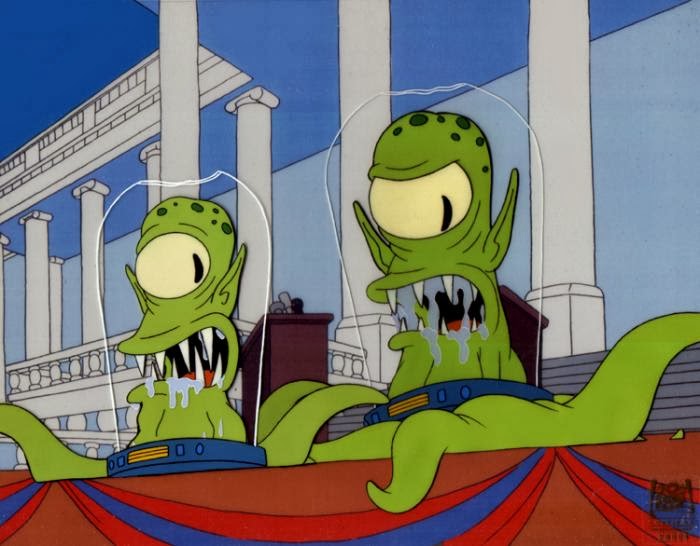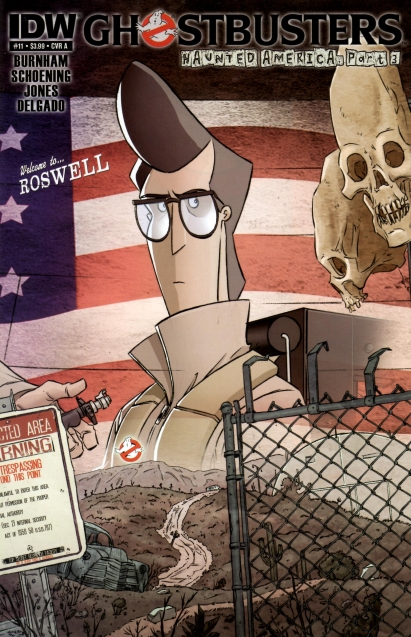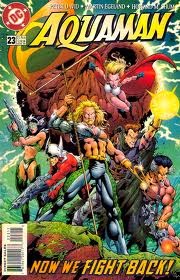Batman #28
Story: Scott Snyder & James Tynion IV
Art: Dustin Nguyen
From Zero Year to Six Months Later, this issue is a peak into the future of Gotham, a city that is actually more bleak than the Gotham that we're used to seeing. It's time again with a check in on Harper Row, Scott Snyder's everyone/new supporting cast member to the Bat books, who tends to pop up during interlude issues between major arcs. Harper is wandering the streets of New Gotham, as it seems to be called, and winds up in the one remaining nightspot. Whatever has happened in Gotham seems to have made it a police state, but since it's Gotham, it's a police state corrupt to its core. While we are definitely in medea res here, but I don't feel totally lost. Writers Scott Snyder and James Tynion IV do a great job of making this feel like a story where we could just continue from and have the backstory filled in. I want to avoid spoiling too much, but since every major comic news site has pretty well spoiled every surprise in the issue (and there were quite a few), I will say that I like Harper's new identity as Bluebird, and I'm curious to see exactly what her relationship is with Batman. I also tend to prefer Batman and Catwoman as allies, the idea of Selina taking over Gotham's rackets is a fascinating one, and Dustin Nguyen's sleek, slinky, American Hustle Selina Kyle is cool not just because it's great, but to show just how versatile an artist he is in comparison to his current work on Li'l Gotham. And that last page reveal! I don't know exactly what this plague that is in Gotham is, and I suppose I'm not supposed to, and I don't know what Spoiler has to do with it, but I'm happy to see her back. Batman: Eternal starts in April, and if you're unsure of whether you're interested in the new weekly, this issue serves as a great peak into that world.
Batman: Li'l Gotham #11
Story & Art: Dustin Nguyen & Derek Fridolfs
Speaking of Dustin Nguyen and Li'l Gotham, the penultimate issue of the most fun Batman comic in years came out this week as well. Making it around to the second year of holidays (each short story is themed around a holiday, and are digital first, so the printed editions don't line up with the holidays within, and since we started with Halloween, this issue brings us back to October), we're not getting the major holidays. The first of the shorts is for All Saint's Day, where Batman has to bring Damian for a supervised visit with his mother and grandfather. By story's end, we get Azrael (Jean Paul Valley, but dressed in Michael Lane's costume), reference to both Neal Adams "hairy chested love God" Batman and Jim Lee's New 52 costume designs, zombie members of the Order of St. Dumas, and Damian riding Man-Bat while fighting them off. The second story, featuring The Clock King and the end of Day Light Savings Time (ok, not really a holiday, but Calendar Man would be good with it too, and that's all that counts to me), has various alternate versions of Batman trying to restart time after Clock King created adevice that has frozen Gotham You get a classic blue-and-grey clad Batman, Zebra Batman, Vampire Batman, FruitBatman, Armored Kingdom Come Batman, and even crotchety old Bruce Wayne from Batman Beyond. It's the kind of craziness that works so well with Batman, better than with pretty much any other superhero; I don't know why, but all those alpha male/type A Batmen tend to have a great crazy rapport, and it's fun to see Clock King freak out and the goofy FruitBatman save the day. The first trade of Li'l Gotham hits this week, and if you're the slightest bit a Batman fan, or have a kid who is, you should really snag this book.
Ms. Marvel #1
Story: G. Willow Wilson
Art: Adrian Alphona
This books technically came out two weeks ago. But amazing sales and great word of mouth made me snag a copy. And I'm really glad I did. This first issue is not in the least bit a super hero comic, with only a hint of the craziness that makes for a superhero story, but is instead more of a teenage drama. Kamala Khan is the kind of teenager we don't get a lot of in comics; she's special in the way we all are, different and interesting, but not "super." She comes from an Islamic household, and her faith is an important part of her character, but not something that defines her. She's sweet, smart, and while I haven't been a teenager for more time than I'd like to admit, the feeling of not fitting in that she is going through is something that most of us can really empathize with. She has a very clear voice, as do all the characters in the title. Her parents and brother only appear for a couple pages, and I already like them, and I already like her friends Bruno and Nakia. And the school alpha girl/mean girl isn't the typical nasty Cordelia Chase clone, but is a condescending little brat who is the perfect example of how some people think their culture is superior to everyone else's. It's also charming to see that Kamala is an Avengers fangirl; I can't wait to see her interact with the Avengers. On top of a really strong first issue script for G. Willow Wilson, the art from Adrian Alphona is top notch. Best know for his work on Runaways, it's great to see Alphona working with a teen hero again. Marvel really pushed this book out into the mainstream, and I often find those attempts hollow, but in this case I'm glad they did. We got a lot of walk in business from people who were either not regular comic fans, or not regulars at out store anyway, and for them to be interested in a comic is great, and since it's a comic of strong quality, I hope it means they'll be back. So, long story short, and pardon the paraphrase Stan, but Make Mine Ms. Marvel!
She-Hulk #1
Story: Charles Soule
Art: Javier Pulido
Now, this was a book I was in for from the beginning. I'm not a huge She-Hulk fan, but the combination of art by Javier Pulido and the fact that this series seemed to be hearkening back to Dan Slott's wonderful couple years on the title that was a combination of law and superheroics had me very excited, and the book delivered. Charles Soule has been all over the place lately, and I've been enjoying his run on Swamp Thing a great deal, and this book is equally well written but has a completely different flavor. Jen Walters, the Sensational She-Hulk, starts out the issue working for a law firm and feeling like everything is going her way. But by the end of the first full scene, she's out of work, and things aren't looking so rosy. But an encounter at a bar has her representing the wife of a C-List villain against Tony Stark's company for stealing his tech, and we see that the law in the Marvel Universe isn't any more straightforward than it is in this world. While Jen doesn't have the same anger issues as her cousin, she still can be bit temperamental when provoked. When getting in to see Tony Stark to just talk doesn't work, she winds up meeting with Stark's chief counsel (a guy who simply calls himself Legal, and who I hope show up again). Jen tries to work within the system, but the little guy versus the multi-billion dollar corporation doesn't go well. So she smashes her way in to see Stark. Hey, can't hurt to be a Hulk. We see every aspect of Jen's personality in this one issue; she's smart, she's tough, she believes in the law, but she will crack some heads if she needs to. By the end of the first issue, everything is wrapped up and a new status quo is set. Yes, you heard me right: the first issue is a done-in-one story. When was the last time that happened in a book from one of the big two? That's two-for-two from Marvel on solid first issues with female characters. Maybe I need to try Black Widow too.









































































































